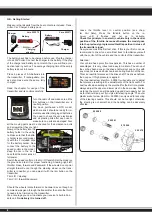
10
ES - Datos técnicos
Emisora CCX 2,4 Car
Frecuencia de
2,4 GHz
Modulo
GFSK
Servo Resolución de
10 bits (1024 pasos)
Modelo Tipo
de coches, barcos
Función de la dirección
2
Dual Rate
Temperatura de
- 15 a + 58 ° C
Voltaje de funcionamiento
9,6 a 12 V
Bajo apercibimiento de voltaje de 9 V
Antena ca longitud.
26 cm
Tensión de
12 V DC (8 elementos)
Recargable
Carga recargable de Jack
DSC-Port (simulador de conducción)
de 3,5 mm Plun enchufe
Medidas
159 x 99 x 315 mm
Peso
328g
Receptor CCX 2,4 GHz Car
Ref. 06 1171
Banda de frecuencia
2.4 GHz
Arte Módulo
GFSK
Disolución de servo de
10 bits (1024 pasos)
Voltaje de funcionamiento
4,5 a 7,4 V C D
Medida
38 x 22 x 13 mm
Peso
6 g
GB - Technical data
Transmitter CCX 2,4 Car
Frequency Band
2,4 GHz
Modulation
GFSK
Servo Resolution
10 Bit (1024 Step)
Model Types
Car, Boat
Channels
2
Dual Rate
Temperature Range
- 15 to + 58° C
Operating Voltage
9,6 - 12 V
Low Voltage Warning
9 V
Receiver Antenna Length
approx. 26 cm
Voltage
12 V DC (8 Cells)
Charging
Via Charging Socket
DSC Port (Simulator Socket)
3,5 mm Audio
Size
159 x 99 x 315 mm
Weight
328 g
Receiver CCX 2,4 GHz Car
Part No. 06 1171
Frequency Band:
2,4 GHz
Modulation:
GFSK
Servo Resolution:
10 Bit (1024 Steps)
Operating Voltage:
4,5 – 7,4 V DC
Size:
38 x 22 x 13 mm
Weight:
6 g
Dispositivos para cargar
Cuando se utiliza un NiCd o NiMH cargador hay que revisar si
las células están totalmente cargadas después de cada uso hay
que recárgala con atención. Preste atención que está utilizando
el número de células recomendado por el fabricante.
Coloque el cargador en uso la ref. 150.004, que un profesional le
ayude. Después, que las células se carguen en la red indepen-
diente del cargador, desconecte el enchufe.
Si se queda el modelo mucho rato sin utilizar, retire las baterías
de la emisora, del modulo. Y, para o cargador de la emisora:
1. Único lugar en las células correctas en el cargador
2. Enchufe el cargador
3. Coloque el cable del cargador en la estación
4. Retire el aparato a la toma de recarga, a continuación,
desconecte el cable de alimentación para recargar y pronto
verifique entonces que las células se están completas /
llenas.
¡Atención!
Al recargar las baterías dejar la tapa abierta.
Charging the battery
If you use NiCad or NiHm rechargeable cells for your transmitter
ensure that the cells are fully charged before using the system.
Please be aware that due to the self-discharge characteristics of
this type of cells that they should always be fully charged prior to
use. Please refer to the battery manufacturers recommendations
regarding charging current etc.
Use only a high quality charger which is suitable for this type of
cells such as our item 15 0004. For further information please
contact your local dealer. Once charging is complete, always dis-
connect the batteries from the charger and unplug the charger
from the mains supply.
Remove the batteries from the model and transmitter if you do
not intend to operate it for a longer period of time. To charge the
transmitter batteries please proceed as follows:
1. Fit the batteries observing the correct polarity.
2. Plug the charger into the household mains.
3. Connect the charging cable to the transmitter.
4. Remove the charging cable and unplug the charger as soon
as the batteries are full.
Warning!
Remove the battery hatch cover whilst charging and the
charge current to max. 1 amp limit. Higher currents can da-
mage the electronics of the transmitter and cause a short
circuit!











































